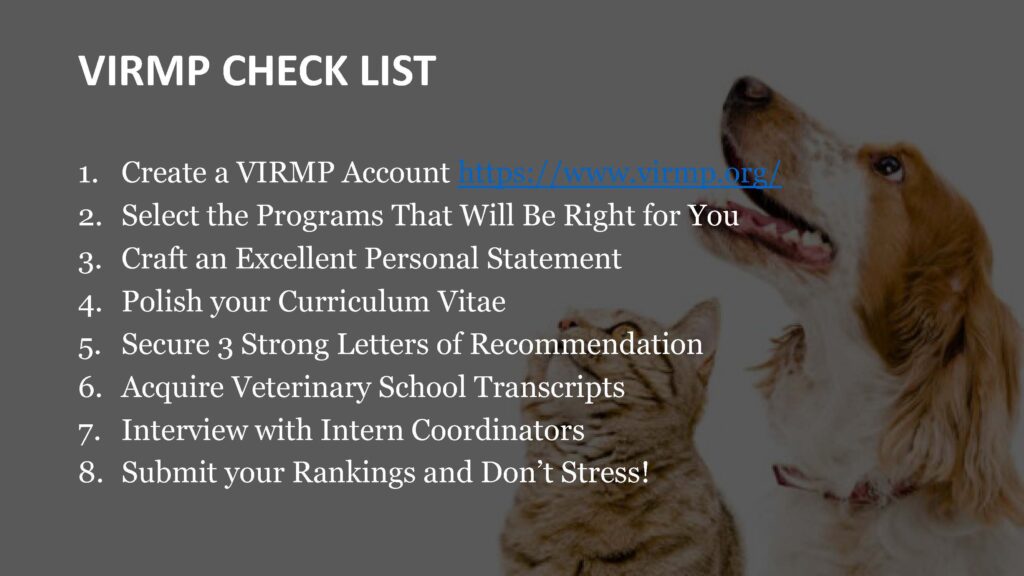Last Updated on June 22, 2022 by Laura Turner
So, you are interested in applying for a Veterinary Internship or Residency position for advanced training after you graduate from veterinary school, but have no idea where to start? The starting point is accessing the Veterinary Internship & Residency Match Program (VIRMP) and making an account. The process can seem long and confusing but follow this checklist to keep yourself on track and break the application down into eight manageable steps.
Create a VIRMP account
An early first step in the VIRMP process is to start an application. This is the official website to apply for the vast majority of Veterinary Internship and Residency programs in the United States, and it includes both academic institutions and private practices. There is a rare subset of programs that select applicants outside of the match, but that is a subject for another article. These programs select veterinary applicants through the match selection process modeled after the match process used for human physicians.
Don’t worry it’s free to make an account, and you are not locked into applying by simply making an account. An added perk of making an account is you will get emails from the VIRMP with reminders on important deadlines for the match application.
Pro-tip: If you are a fourth-year veterinary student, be sure to register your account with an email that you check frequently but is different than your current veterinary school email. School emails are often shut down shortly after students graduate, and the email you plug into the VIRMP will be the main means that program coordinators will use to reach out to you. The last thing you want is to miss important emails from a potential future mentor!
Select the right programs for you
The next step is to surf the VIRMP website for programs that interest you. This process can be overwhelming with over 550 internship programs and over 350 residency programs in the 2020-2021 application cycle, but overall, it can fun to see all the great programs out there. When you are ready to submit your application, you can choose to apply to up to ten programs for $90, up to 20 programs for $250, or an unlimited number of programs for $350. While applying to ten or fewer programs generally works well for the standard internship, applying to more programs can be helpful if your list is full of very competitive internships or seeking a competitive residency such as surgery.
Use the program search page to filter down the list of programs by selecting the type of position (specific internship and residency types), type of institution (universities and private practices), and the location (by state). Other important factors to consider that you cannot filter for include salary to cost of living ratio, hospital resources and patient load, and the numbers and types of specialists at each program. While a whole article could be dedicated to optimizing your program selection process, my main recommendation is to set up a pro and con list on a spreadsheet to organize your thoughts.
Craft an excellent personal statement
While many of us dread writing about ourselves, the personal statement is a necessary part of the VIRMP application, and you should view it as an opportunity to highlight the skills/past experiences that make you unique and elaborate on how you plan to use these attributes in your desired position. Here is the prompt directly from the VIRMP website:
“Your personal statement should be one to two pages in length and discuss your expectations of an internship/residency program and your future professional goals. In addition, we encourage you to describe your anticipated contributions to your matched institution. These may include life experiences, background, past activities or unique personal characteristics that would contribute to the program in meaningful ways.”
As daunting as the process may be, it is best to start writing drafts early so that you have ample time to show them to as many colleagues and mentors as possible. Your goal should be to produce a statement that speaks well to your professional interests and skills with absolutely no grammatical errors.
Pro-tip: While the prompt lists one to two pages, do your best to keep your personal statement under one page. Program coordinators are having to sort through many applications so keeping your personal statement concise, direct, and engaging is key to maintain a captive audience, which is likely a very busy program coordinator whose time and attention span are limited.
Polish your curriculum vitae
It is important to note the VIRMP requests a curriculum vitae (CV), which is different from a resume in the sense that your CV is an extensive record of all of your relevant academic and veterinary experiences. It is not unreasonable to have a CV up to five to six pages at this point in your career, while your resume should be one to two pages and only list experiences related to a specific job. Organizing your CV can sound tricky, but follow this general formula will get off to a good start:
Education, Veterinary Experience, Instructional Experience (TA positions), Research/Grants, Publications & Presentations, Professional Activities (Club/leadership positions), Awards, Licenses & Certifications, References
Pro-tip: Contact your school’s career resource center to get help honing your CV. There are lots of little nuances in how to best present your experience, so save yourself the headache and get some professionals insight. Most universities offer these services for free! It may just take some research on your part to find the right person to contact.
Secure three strong letters of recommendation
The importance of strong letters of recommendation (LORs) cannot be emphasized enough! Studies have shown that LORs are one of the most important factors used by internship selection committees. These letters should come from veterinarians, who can speak to your unique strengths through directly working with you on the clinic floor or a research project.
Pro-tip: Consider the reputation of the veterinarians you choose for your LORs, especially if applying to academic programs. Surveys of program coordinators have shown that name recognition of the person writing the LOR is just as important as the content in the LOR. So, it is a good idea to seek connections with faculty members who are heavily involved in prominent research or national conferences. The world of veterinary medicine is a small one with many veterinary specialists being interconnected all across the country, so always strive to make good impressions and you will build a strong reputation for yourself before you even realize it.
Acquire veterinary school transcripts
Every veterinary school probably has its own way of doing this, but it is safe to anticipate that the process could take several weeks as many colleges still only provide official transcripts through physical mail as opposed to email. If this is the case, you will then need to scan the transcripts onto your computer so that you can upload them to the VIRMP application website.
Because of the timing of the VIRMP application is likely that you will not have all your final grades back even for courses that you are taking in the fall semester. This is okay, and it is widely accepted to simply send the most up-to-date transcripts you can from November of the year that you are applying. Depending on when applications are due this year (December vs January) you can potentially wait until the end of the fall semester in hopes of getting those additional grades onto your transcript, but you will have to weigh if one or two more grades is worth the stress of trying to secure transcripts from your college around the winter holidays.
Interviews
Unlike veterinary school applications, interviews are actually not a huge part of the VIRMP application process. Many programs do not even conduct interviews and those that do are usually less formal than traditional veterinary school interviews. These interviews often last less than 45 minutes and often include a mix of basic professional skill/interest questions, walking through a mock emergency case, and informal conversations about your hobbies and personal life. It is good to check on the program description page to see if the programs you applied to plan to conduct interviews. If they do not clearly specify, do not be afraid to introduce yourself over email to the program coordinator and request more information about their possible interview process.
If you are requested to attend an interview, you should prepare as you would for any job interview. Prepare answers for basic questions about your professional interests, strengths, weaknesses, hobbies, etc. It is always a good idea to look up specific information about the practice and even better if you can look up some facts about your interviewer beforehand. Lastly, while it is impossible to prepare for the myriad of specific veterinary medical questions you could be asked in a case series, it is not a bad idea to review your basic emergency medicine and triage notes as most intern programs have a heavy emergency focus.
While COVID restrictions are lifting across the country, the pandemic opened the flood gates for the convenience of zoom interviews that will probably remain open for years to come if not indefinitely. So, while visiting programs would be wonderful if you have the time and funds, do not be afraid to suggest a zoom interview if traveling is not an option for you. Just be sure to take all the appropriate zoom interview precautions (wear professional clothes, ensure good lighting, clean your room, control your noisy roommates and pets)!
Submit your rankings and don’t stress
Finally, after completing any interviews that you might have, you need to rank the programs that you are applying to start with number one for the program that you would most like to attend and so on. If you applied to a program that you no longer wish to attend, you should not rank it. For example, if you applied to ten programs and you decide that you would not want to go to your tenth favorite program, then DO NOT RANK IT. There is no penalty for not ranking all the programs that you applied to. However, if you do rank a program, it means you are agreeing to attend that program if you are matched with them. If you break this agreement, then you will be prevented from applying through the VIRMP for three years. So again, ONLY RANK THE PROGRAMS YOU WANT TO ATTEND!
Once your rankings are submitted (usually in January or February) there is nothing left to do but wait until match day (usually March 1st) and then check the VIRMP website to see where you matched. For applicants that do not match with any of the programs they applied to, there are options to take up open positions from other programs through what some call the “scramble”. While this process is quite elaborate and can be a major stressor for fourth-year veterinary students, it is best to try and not let you stress yourself out too much. You can only do your best to build a strong application and pick programs that you would be excited to attend. After that, you simply have to leap of faith and trust that the process works and that you will end up where you are supposed to be.

